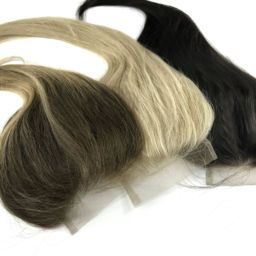Hair loss: The latest science on causes, treatment, and prevention
CREDIT: Medical News Today
In the past decade, biologists have disentangled many of the complexities of how hair grows and how it is lost in conditions such as pattern baldness and alopecia areata. In this Special Feature, we explore the latest discoveries and treatments, and ask experts if it is possible to prevent hair loss in the first place.
It is perfectly normal for people to shed between 50 and 100 hairs from their heads every day, according to the American Academy of Dermatology Association.
However, excessive hair loss that causes progressive thinning of the hair, bald patches, or even total hair loss can be very distressing.
There are several possible causes of hair loss. These include:
- major stressors, such as a prolonged illness, job loss, or a bereavement — this kind of hair loss is known as telogen effluvium
- some medications, including antidepressants, beta-blockers, levodopa, and chemotherapy drugs
- illnesses such as thyroid disorders, a sex hormone imbalance, or a dietary deficiency of protein, iron, zinc, or biotin, for example
- autoimmunity, which can cause hair to fall out in one or more small patches on the scalp, eyebrows, or eyelashes — this is known as alopecia areataTrusted Source
- tight hairstyles that strain the hair follicles, known as traumatic or traction alopecia
- a combination of genetics, male hormones, and increasing age, known as pattern hair loss or androgenetic alopecia; this can affect both males and females.
The biology of hair growth is complex, but in recent years scientists have made strides toward understanding how the various factors listed above cause hair loss. They hope that in time this will lead to new, more effective treatments.
Growth cycles in hair follicles
A hair follicle is a tube-like skin pore that encloses the shaft and root of the hair. Most healthy adults have around 80,000–120,000Trusted Source hairs on their scalps.
Each hair follicle repeatedly undergoes a growth cycle that comprises three distinct phases: anagen, catagen, and telogen.
During anagen, which lasts between 2 and 7 years, the hair within the follicle grows about 1 centimeter per month.
The follicle then enters catagen, a 2-week transitional phase during which the hair detaches from the blood supply.
During the final, inactive stage, or telogen, the follicle sheds the hair. It can then take up to 4 months before the follicle starts to grow a new one.
Two to 3 months after a person experiences a traumatic or stressful event they can develop telogen effluviumTrusted Source — a type of hair loss in which the follicles remain stuck in the inactive, hair-shedding stage.
How chronic stress triggers hair loss
In March 2021, scientists revealed how chronic stress can keep hair follicles in this inactive state for longer.
The hair follicle is one of the few tissues in the body that can regenerate itself, thanks to special cells known as adult stem cells. Researchers at the Harvard Department of Stem Cell and Regenerative Biology in Cambridge, MA, discovered how chronic stress in mice suppresses the activity of these cells.
They showed that a stress hormone called corticosterone — which is the mouse equivalent of cortisol in humans — keeps the follicle stem cells inactive.
They found that in the absence of circulating corticosterone, the stem cells underwent many more rounds of regeneration during the animals’ lifetime. By contrast, high levels of the hormone, as a result of chronic stress, kept them inactive for longer and led to fewer rounds of regeneration.
Rather than directly affecting the stem cells, however, corticosterone acted on a cluster of cells under the follicle, known as the dermal papilla.
The researchers showed that in mice, the stress hormone prevented the dermal papilla from producing a molecular signal called Gas6, which normally activates the follicle stem cells.
They reported their findings in NatureTrusted Source.
“Under both normal and stress conditions, adding Gas6 was sufficient to activate hair follicle stem cells that were in the resting phase and to promote hair growth,” says Dr. Sekyu Choi, who was the lead author of the study.
“In the future, the Gas6 pathway could be exploited for its potential in activating stem cells to promote hair growth,” he adds.
The researchers say they will need to conduct more studies in mice before they can explore potential treatments in humans.
Does a muscle drive hair loss?
Scientists have also discovered how a muscle that surrounds each hair follicle may play a role in hair loss and regeneration.
The muscle, called the dermal sheath, is a type of “smooth muscle.” This means that — unlike skeletal muscle — it is not under voluntary control.
The team led by researchers at the Icahn School of Medicine at Mount Sinai in New York investigated the role of the dermal sheath in mice.
They showed that the muscle physically drives hair follicle regression, which is the middle part of the hair growth cycle, or “catagen.” The scientists found that when it contracts, the dermal sheath squeezes the hair follicle to start the regression process.
At the same time, this relocates the dermal papilla cells from under the follicle, up through the skin to where the stem cells are found in the upper follicle. In its new position, the dermal papilla can then signal to the stem cells to start generating a new hair.
The researchers showed that the same contraction machinery operates in human hair follicles. They believe that if they can prevent the muscle from contracting, they can stop hair follicle regression in its tracks.
“Blocking the newly discovered muscle and its contraction cannot cure baldness caused by hair loss diseases,” emphasizes Dr. Michael Rendl, who was the senior author of the study.
But by stopping the “destruction phase” of the cycle, he points out, this could keep the existing hair shaft that would otherwise be lost when a new hair is produced.
“We are excited about the possibility of stopping follicle regression and preventing the loss of the existing hair,” he says.
The scientists described their study in Science in January 2020.
Hair follicles in a dish
For the first time, researchers have grown fully functional mature mouse hair follicles in vitro in the lab — in other words, outside a living animal. The “hair follicle organoids,” or “follicloids,” produced hair shafts that grew around 3 millimeters in 23 days.
The researchers hope that their cultured hair follicles will be useful for studying the biology of hair growth and pigmentation, and to screen new drugs.
In October 2022, they described their mouse hair follicloids in Science Advances.
“Our next step is to use cells from human origin, and apply [the technique] for drug development and regenerative medicine,” says senior author Dr. Junji Fukuda, a professor in the faculty of engineering at Yokohama National University in Japan.
Their work could offer opportunities to develop new, more effective treatments for hair loss, such as androgenetic alopecia.
However, the follicloids do not undergo growth cycles in the same way as normal hair. To reproduce hair cycles, it may be necessary to transplant the hair follicles into living animals.
Prof. Fukuda told Medical News Today that he and his colleagues have recently achieved this with individual follicles, which each contain a hair shaft up to 10 millimeters long.
“From the results, we think that signals from the body are necessary for hair cycles,” he said.
Since their recent study was published, they have also grown human hair follicles from stem cells, though for now these follicles remain at an immature stage.
Existing drug treatments
Pattern hair loss
Pattern or androgenetic hair loss affects up to halfTrusted Source of males and females. People with the condition are genetically predisposed to have a stronger response to androgens (male hormones) in their scalp.
Activation of androgen receptors in dermal papilla cells shortens the growth phase (anagen) of hair follicles. In people susceptible to pattern hair loss, excessive activation of the receptor progressively shrinks the follicle, which results in shorter, thinner hairs.
People with the condition produce more of a potent androgen called dihydrotestosterone (DHT). They also have more androgen receptors in their scalp, and higher levels of an enzyme called 5 alpha-reductase, which converts testosterone to DHT.
There are two Food and Drug Administration (FDA)-approved drugs for pattern hair loss: finasteride and minoxidil.
Finasteride works by inhibiting 5 alpha-reductase to reduce levels of DHT in the scalp.
However, the drug’s efficacy is unclear in females, and some doctors advise females who are looking to get pregnant against taking it because the drug can cause a male fetus to develop ambiguous genitalia.
As an alternative, females with pattern hair loss can take a drug called spironolactone, which is a less potent inhibitor of androgen activity than finasteride.
Minoxidil solution — Rogaine in the United States and Regaine in the United Kingdom — which is applied directly to the scalp, dilates blood capillaries. This may promote hair follicle growth by allowing more blood, oxygen, and nutrients to reach them.
Minoxidil is safe for both men and women.
Alopecia areata
In June 2022, the FDA approved the first treatment for a type of hair loss in which the immune system attacks hair follicles, known as alopecia areata.
The drug, called baricitinib, was already approved for the treatment of another autoimmune disorder, rheumatoid arthritis.
It works by inhibiting the activity of enzymes known as Janus kinases, which in turn may block some of the molecular signals that cause autoimmune disease.
In clinical trials, the drug was better than placebo at promoting hair regrowth in people with severe alopecia areata.
How to minimize hair loss
Hair loss is an inevitable part of the aging process in both men and women. However, there are ways to protect hair follicles and slow down hair loss.
“As soon as you notice you are losing hair, make an appointment with a health care practitioner, like a dermatologist,” advised Dr. Reid Maclellan, the founder and CEO of Cortina Health, and adjunct professor of plastic surgery at Harvard Medical School in Boston, MA.
“The sooner you consult an expert, you may be able to start treating it quickly and minimize further hair loss,” he told MNT.
If hair starts to thin, he advised against the use of hot tools, blow dryers, aggressive towel drying, and tight hairstyles such as buns.
Dr. Ron Chao, a cosmetic, plastic, and hair transplant surgeon at Barber Surgeons Guild in New York, cautioned:
“There are literally hundreds of products, shampoos, vitamins, supplements etc. on the market that claim to help with hair loss, but as a professional, I only officially recommend those that are currently clinically FDA approved which are oral finasteride, topical minoxidil and low-level class 3 lasers.”
Low-level laser therapy — also called red light therapy or cold laser therapy — irradiates the scalp to promote blood circulation and encourage hair growth.
In 2020, a review of research concluded that the treatments are safe and effective for both men and women.
“If you’re concerned about androgenetic hair loss, it is critical to work closely with a physician to ensure that there are no other underlying causes of the hair loss,” advised Dr. Geeta Yadav, a board-certified dermatologist and founder of FACET Dermatology.
“A physician might recommend blood work or even imaging,” she added.
For example, blood tests to check for dietary deficiencies might include ferritin and vitamin D levels.
“Healthy habits that patients can do themselves include following a nutritious diet and trying to keep stress levels low,” she advised.





